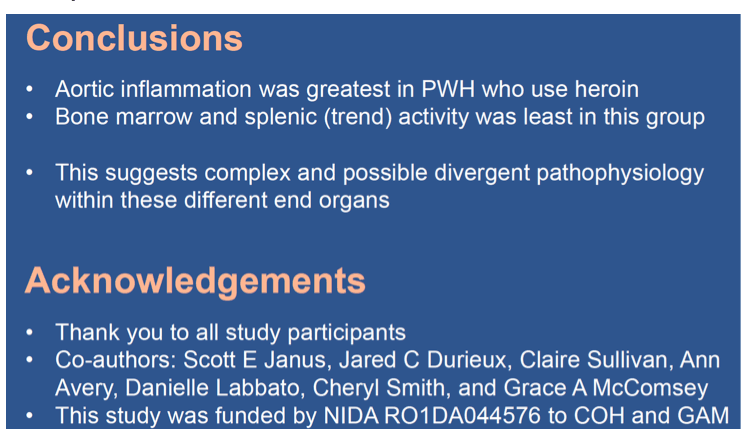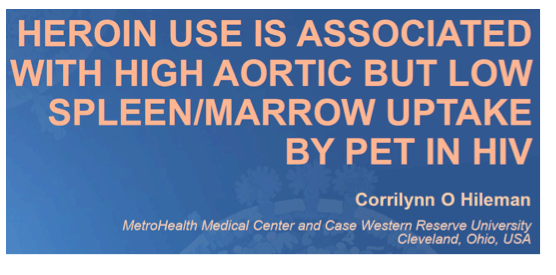 |
 |
 |
| |
HEROIN USE IS ASSOCIATED WITH HIGH-AORTIC
BUT LOW-SPLEEN/ MARROW UPTAKE BY PET IN HIV
|
| |
| |
CROI 2021 March 6-10 Reported by Jules Levin
Corrilynn O . Hileman1, Scott E. Janus2, Jared C. Durieux2, Claire Sullivan2, Ann K. Avery1, Danielle Labbato2, Cheryl Smith1, Grace A. McComsey2
1MetroHealth Medical Center, Cleveland, OH, USA, 2University Hospitals Cleveland Medical Center, Cleveland, OH, USA
Background: Heroin use may work synergistically with HIV infection to cause greater immune dysregulation than either factor alone. Unraveling how this affects end organ disease is key as it may play a role in the excess mortality seen in people with HIV who use heroin even despite access to care and antiretroviral therapy.
Methods: In this prospective, cross-sectional study, adults with and without HIV who use and do not use heroin underwent FDG-PET to compare tissue specific inflammation, aortic (target-to-background ratio or TBR), splenic and bone marrow (standardized uptake value or SUV). Least squares regression was utilized to compare means between 1) HIV+ heroin+ vs HIV+ heroin-, 2) HIV- heroin+ vs HIV- heroin, and 3) HIV+ heroin+ vs HIV- heroin+ and test for effect modification (heroin use-by-HIV status interaction).
Results: 110 participants enrolled (23 HIV+ heroin+, 51 HIV- heroin+, 20 HIV+ heroin-, 16 HIV- heroin-). Median (IQR) age was 41 (33, 51) yrs; 74% were men. Heroin+ were more likely Hispanic regardless of race (23 vs 6%), smokers (99 vs 44%) and to have active hepatitis C (57 vs 0%) (p<0.01 for all). Among HIV+, heroin users had lower current (591 vs 790 cells/mm3), but similar nadir CD4 counts (247 cells/mm3), HIV duration (12 yrs) and proportion with HIV-1 RNA <200 copies/mL (91%). Aortic TBR was 0.41 higher in HIV+ heroin+ than HIV+ heroin- (p=0.03) and 0.26 higher than HIV- heroin+ (p=0.09) which attenuated slightly with adjustment, but were still apparent (Figure). The effect of heroin use on splenic and bone marrow SUV was opposite. Splenic (bone marrow) SUV was 0.21 (0.43) lower in HIV+ heroin+ than HIV+ heroin- (p=0.05 for spleen and p<0.001 for bone marrow) and 0.13 (0.33) lower than HIV- heroin+ (p=0.13 and p<0.0001). The differences attenuated for splenic SUV with adjustment, but remained significant for bone marrow SUV. Additionally, HIV status modified the effect of heroin use on bone marrow SUV (Figure).
Conclusion: Aortic inflammation was greatest in HIV+ heroin+, but paradoxically bone marrow and splenic (trend) activity was the least in this group suggesting complex and possibly divergent pathophysiology within these different end organs.


|
| |
|
 |
 |
|
|